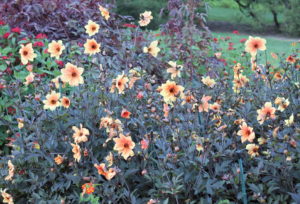Dark-leaf dahlias
* Common name: Dark-leaf dahlia
* Botanical name: Dahlia
* What it is: Dahlias are big, showy, prolific, daisy-like flowers that come in all sorts of flower colors, ranging from creamy white to hot red with most every shade and combo in between (except blue). Most flower from late summer into early fall.
Particularly striking are varieties with dark and sometimes nearly jet-black leaves, which make the flowers really stand out. Impressive varieties include ‘Fascination’ (pink double flowers), ‘Bishop of Llandaff’ (red semi-double flowers), ‘Happy Single Party’ (yellow single flowers), and ‘Best Bett’ (peachy single flowers).
* Size: Large “dinner-plate” dahlias can grow 3 to 4 feet tall with flowers rivaling sunflowers in width. Border dahlias grow 1 to 2 feet tall. Smallest ones grow 10 to 18 inches tall. Space 1 to 2 feet apart, depending on type.
* Where to use: Plant in clusters of at least three to five in border beds or perennial gardens. Tall ones should go at the back of a bed. Smaller ones can go in pots, window boxes or sunny foundation gardens. All dahlias prefer raised beds and well drained soil; no soggy clay. Best flowering is in full sun.
* Care: Plants grow from sweet-potato-like growths called tubers that are planted in May after danger of frost has passed in loosened, well drained soil about 2 to 3 inches deep. Work a balanced, organic, granular fertilizer formulated for flowers into the soil at planting, then scatter another round about eight weeks later.
Stake taller types at planting, being careful not to puncture planted tubers. Keep soil damp but never soggy throughout summer.
Snip off flower stalks when blooms fade. When first frost browns the foliage in fall, remove tubers, cut off all but 2 inches of foliage, and let tubers air-dry out of direct sun for five to seven days. Gently brush off excess soil and store each clump of tubers in a box or basket in slightly moistened sand or peat moss – ideally in a cool, dry spot at 45 and 55 degrees. Check tubers during winter and mist them lightly if they’re drying/shriveling, or store them in fresh, dry medium (or toss) if any show signs of rotting.
* Great partners: A mass of dark-leafed dahlias are as showy as any plant, and so they can more than hold their own alone. A backdrop of tall evergreens, such as arborvitae or holly, sets them off like a star performing in front of a curtain. Or “bookend” them with ornamental grasses or compact evergreens, such as upright boxwoods, dwarf Hinoki cypress, or dwarf cryptomeria.








